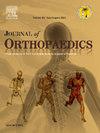机器人手术助手 (ROSA) 功能性对位 TKA 是否比传统机械性对位 TKA 带来更高的满意度:倾向匹配配对分析
IF 1.5
Q3 ORTHOPEDICS
引用次数: 0
摘要
目的全膝关节置换术(TKA)是治疗严重膝关节骨性关节炎的成熟疗法,机器人辅助全膝关节置换术(rTKA)可提高手术精确度并改善预后。本研究探讨了使用 ROSA 膝关节系统进行功能性对位的 rTKA 与传统的机械性对位 TKA(mTKA)相比,是否会带来更优越的功能性治疗效果和患者满意度。使用 ROSA 膝关节系统进行了功能性对齐(FA)rTKA。患者在术前和术后 6 个月接受短表 36 (SF36)、膝关节协会膝关节评分 (KSKS)、膝关节协会功能评分 (KSFS) 和牛津膝关节评分 (OKS) 评估。术后近期疗效,如静息和运动时的疼痛、行走距离和活动范围,均进行了测量。统计分析以 95% 的置信区间对结果进行评估,显著性以 P < 0.05 为标准。结果两组患者在术后即刻的休息时疼痛(P = 0.988)、运动时疼痛(P = 0.634)、行走距离(P = 0.243)和活动范围(P = 0.752)方面均无显著差异。在 6 个月时,rTKA 和 mTKA 在 SF36(P = 0.996)、KSKS(P = 0.150)、KSFS(P = 0.091)和 OKS(P = 0.949)达到最小临床重要性差异方面无显著差异。结论术后 6 个月时,FA rTKA 与 mTKA 相比,结果和满意度相当。未来的研究应侧重于检查更长期的随访结果,量化 MA mTKA 的间隙平衡,以便与 rTKA 进行直接比较,并研究其他个性化对位 rTKA 策略,以提高患者的治疗效果。本文章由计算机程序翻译,如有差异,请以英文原文为准。
Does robotic surgical assistant (ROSA) functionally aligned TKA lead to higher satisfaction than conventional mechanically aligned TKA: A propensity-matched pair analysis
Objectives
Total knee arthroplasty (TKA) is the established treatment for severe knee osteoarthritis, with robotic-assisted TKA (rTKA) proposed to enhance surgical precision and potentially improve outcomes. This study investigates whether functionally-aligned rTKA using the ROSA Knee System results in superior functional outcomes and patient satisfaction compared to conventional mechanically aligned TKA (mTKA).
Methods
We conducted a retrospective, propensity-score matched cohort study including 154 patients (46 rTKA, 108 mTKA) who underwent primary TKA by a single surgeon from October 2020 to October 2023. Functionally-aligned (FA) rTKA was performed using the ROSA Knee System. Patients were assessed using the Short-Form 36 (SF36), Knee Society Knee Score (KSKS), Knee Society Function Score (KSFS), and Oxford Knee Score (OKS) preoperatively and at 6 months postoperatively. Immediate postoperative outcomes such as pain at rest and movement, ambulation distance, and range of motion were measured. Statistical analysis evaluated results at a 95 % confidence interval, with significance at P < 0.05.
Results
No significant differences were observed in immediate postoperative pain at rest (P = 0.988), pain during movement (P = 0.634), ambulation distance (P = 0.243), and range of motion (P = 0.752) between the groups. At 6 months, there were no significant differences between rTKA and mTKA in achieving the minimal clinically important difference for SF36 (P = 0.996), KSKS (P = 0.150), KSFS (P = 0.091), and OKS (P = 0.949). No significant differences were noted for satisfaction levels (P = 0.315) and fulfilled expectations (P = 0.557) between both groups.
Conclusions
At 6 months postoperatively, FA rTKA demonstrated equivalent outcomes and satisfaction levels compared to mTKA. Future research should focus on examining longer-term follow-up outcomes, quantifying gap balance in MA mTKA to allow direct comparison with rTKA and studying alternative personalised alignment rTKA strategies to enhance patient outcomes.
求助全文
通过发布文献求助,成功后即可免费获取论文全文。
去求助
来源期刊

Journal of orthopaedics
ORTHOPEDICS-
CiteScore
3.50
自引率
6.70%
发文量
202
审稿时长
56 days
期刊介绍:
Journal of Orthopaedics aims to be a leading journal in orthopaedics and contribute towards the improvement of quality of orthopedic health care. The journal publishes original research work and review articles related to different aspects of orthopaedics including Arthroplasty, Arthroscopy, Sports Medicine, Trauma, Spine and Spinal deformities, Pediatric orthopaedics, limb reconstruction procedures, hand surgery, and orthopaedic oncology. It also publishes articles on continuing education, health-related information, case reports and letters to the editor. It is requested to note that the journal has an international readership and all submissions should be aimed at specifying something about the setting in which the work was conducted. Authors must also provide any specific reasons for the research and also provide an elaborate description of the results.
 求助内容:
求助内容: 应助结果提醒方式:
应助结果提醒方式:


